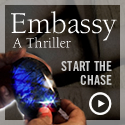16.Aug.2010 | Rachel Balik
Bridging the Gap: Authors and Apps
In Super Sad True Love Story, Gary Shteyngart envisions a not-so-distant dystopic future in which books are artifacts, “Assertiveness” is a college major and immortality is for sale. The book’s protagonist, Lenny, still reads, writes in a journal and thus is essentially a dinosaur. But when the financial crisis hits New York, it’s up to old-fashioned Lenny to save the world with language–and love for a young woman named Eunice.
The book has been compared to George Orwell’s 1984 for its sharp cultural criticism. And while Shteyngart’s satirical prose comes down hard on the damage computers have done to humanity, the author still has his own iPhone app. Download it and you’ll get excerpts from his writing, bonus content, integration of Facebook and Twitter, video clips and breaking news about the author.
In context it seems ironic, but it might simply be a sign of the times. Ultimately, apps don’t signify the death of reading–rather, tablets and e-readers are encouraging more people to buy books.
And often, apps enable readers to engage more fully with the content they’re consuming. Novelist John Reed created a companion iPhone app that lets readers contribute and converse about his new book, Tales of Woe. Tales of Woe compiles true stories of tragedy and misery, and with the iPhone app, readers can contribute their own unhappy stories.
More and more, apps are a tool that accompany books and represent authors in the mobile sphere. For examples, Karen Armstrong’s decision to create a Vook, A Compassionate Life in 12 Steps, caught the attention of Knopf. Soon, the book version of Armstrong’s Vook will be released. It’s proof that when the publishing industry embraces technology, an infinite stream of possibilities can unfold.
Related posts:
























